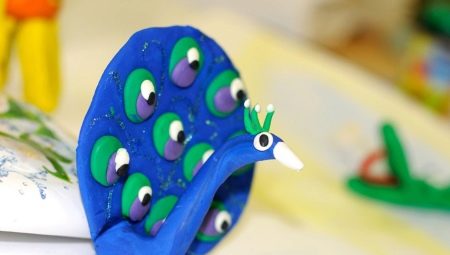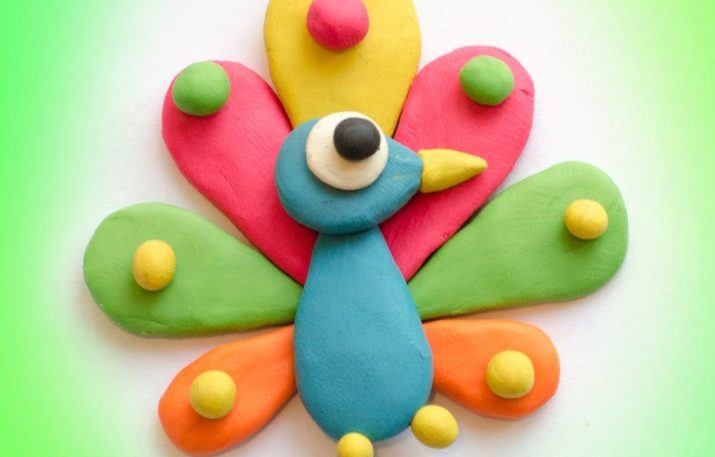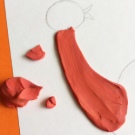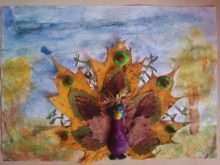How can you mold a peacock from plasticine?

Plasticine is a malleable material from which you can make a variety of figurines. Especially children like to make different animals and birds. In this article, we will figure out how you can mold a beautiful peacock from plasticine.






Classic version
The most popular is a simple scheme for making a peacock from plasticine mass. It can be mastered even by the smallest masters who are still poorly familiar with all the features of working with plasticine.
- The first step is to shape the body and head of the future peacock. It is recommended to make these basic elements from blue plasticine mass, but you can use other options if the child so desires.
- After that, you can move on to making the eyes and beak. For these purposes, you will need to roll several balls that differ in size. In total, you should get 5 pairs of plasticine balls. Three pairs should be rolled from white material, and 2 more from black.
- The first two white balls should be made drop-shaped. These elements will need to be slightly flattened with your fingers. The blanks are glued to the peacock's head. After that, one by one it will be necessary to attach the remaining flattened balls of plasticine mass.
- The beak of a beautiful bird can be made from two plasticine pieces of different sizes. For this, it is best to use a plastic material of yellow, orange or red color.
- After that, you need to connect 2 main elements of the craft: the body and the head.
- Then you can start forming the wings. Their color can be almost anything.It is necessary to make flattened drop-shaped blanks. Using a stack or a toothpick, you can apply a pattern to them in the form of imitation of fluffy feathers. All the details will need to be neatly but firmly combined into a single composition.
- Now we need to make the tail. To do this, small and very small details in the form of drops are made from dark plasticine mass.
- A corresponding bright pattern should be formed on each feather. It can be made using different-sized plasticine balls. In this case, you can use absolutely any color combination.
- The feathers need to be connected in such a way that they form a fan. The blank is attached to the body of the bird.
- Next, they make the legs and crest of a plasticine peacock.
If you want, the finished craft can be supplemented with various decorations and decorations in the form of plasticine patterns in contrasting colors.






How to make on cardboard?
A plasticine peacock made in the form of a spectacular applique will turn out to be no less original and beautiful. To make such an interesting craft, you will need to prepare the following components:
- cardboard sheet;
- plasticine mass;
- special chenille wire;
- stack;
- stationery.


Let's analyze a step-by-step master class for making a beautiful bird on cardboard.
- The first step is to make a sketch of a peacock on a cardboard base or paper.
- Next, you need to take a piece of plasticine of any color you like. Slowly they need to fill in the applied drawing along the contour. The first thing to do is to make the peacock's neck.
- Using a plastic or wooden stack, the bird's neck can be textured.
- Next, proceed to the design of the head. A couple of circles of a different color are formed from plasticine. The eyes and beak are added to these elements.
- Then you need to take plasticine, the color of which is combined with the shade of the peacock's neck. From the selected mass, you will need to roll up two flagella. They will need to be glued as peacock legs.
- The body of a bird can be designed from several multi-colored circles. For this purpose, many identical small balls are rolled, and then, by pressing, they are glued to a cardboard base with the contours of a bird.
- Using green plasticine, you can form a grassy meadow under the paws of a bright peacock.
- Next, you need to take the chenille wire. These components, made in different colors, are used to make a peacock's tail, as well as beautiful wings and an elegant crest. As a result, the original applique will get a very interesting relief.
The finished plasticine applique can be inserted into the frame, but it is better not to store such things behind glass. Very soon, the plastic material will begin to deform under these conditions. The shape of the craft will inevitably deteriorate.






How to mold with cones?
A spectacular peacock can be made from a combination of plasticine and natural materials. Consider the step-by-step instructions for making a bright bird with cones.
- The peacock should start with a beautiful tail. To do this, you need to take a flattened circle of plasticine of any color you like. Next, you need to roll out multi-colored plasticine balls of different sizes. You need to form a pattern by putting these components on top of each other.
- Having made a bright tail, you can proceed to making the torso. The cone must be cleaned of all dirt and dust. This component must be placed with the base down on a plasticine stand. Then the legs are formed.
- Now you can stick the eyes, beak and crest.
- The bird's wings are shaped like a drop. These elements must be fixed on the sides of the natural material.
- The original craft should be completed by attaching the tail to the body of the peacock from a cone.





DIY figurine with leaves
A very interesting and bright peacock can be made from plasticine and autumn leaves. The most beautiful crafts come out using maple foliage.
There are many ways to make a plasticine peacock with these natural materials. You can use the applique technique.



Let's consider step by step how you can make an elegant peacock with your own hands using maple leaves.
- Bulky autumn leaves will make a first-class peacock tail. You can fix the foliage on a piece of paper or cardboard. It is advisable to fix these components in layers to create a noticeable volume.
- When the elegant tail is fixed on the base, you can proceed to making the body and head of the bird. First, you need to cut a peacock out of colored paper and stick it over the foliage, and then stick a plasticine mass of different colors over the paper contours. You can do without a base of colored paper, but with it, making it will be easier for the child.
- A bouncy maple tail can be effectively decorated in a variety of ways.
Crafts in which this element is complemented by multi-colored beads and shining rhinestones look especially elegant.


Useful Tips
Consider some useful tips related to making a plasticine peacock.
- If the child is still little familiar with plasticine masses, one should not immediately choose complex techniques for making crafts. It is advisable to start with the simplest and most understandable options. More complex schemes can be mastered later.
- For modeling, you can use a standard or light type of plasticine. The lighter option will be more malleable, but it quickly hardens. It does not need to be kneaded. It is not recommended to buy sculptural plasticine for a child, since it has a high level of rigidity.
- When working with plasticine, it is important to knead it at every stage of making the craft. Thanks to this, the material will be more pliable and soft, it will be easier for the child to work with it.
- Any natural materials before starting the manufacture of crafts must be thoroughly cleaned of any dirt and dust. The child should only work with clean and dry components.
- You can sculpt figures on a special convenient board, or you can simply on the table. If the second option is chosen, then you cannot do without oilcloth, paper or newspapers in order to avoid the appearance of greasy plasticine marks on the furniture.


For information on how to mold a peacock from plasticine, see the next video.








